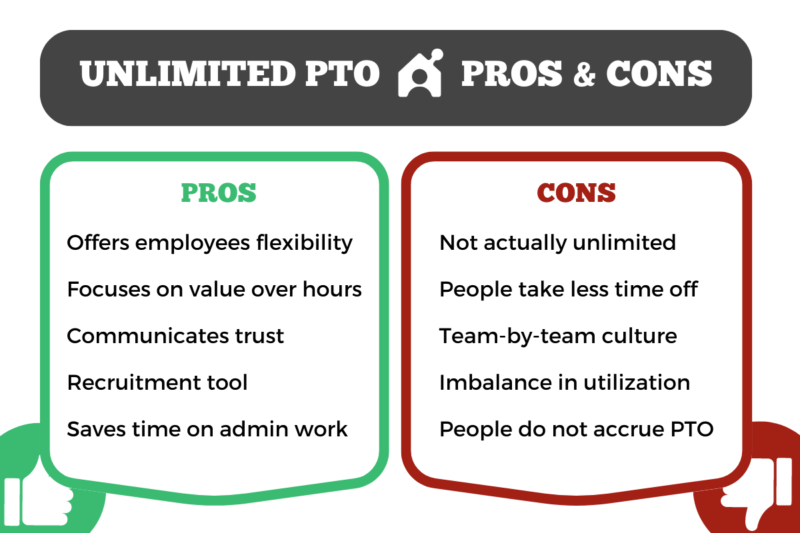Unlimited PTO Pros & Cons: The Full Analysis

Amid all the chatter about unlimited PTO as the hot new trend in leave policy, something that often goes unmentioned are its drawbacks. While greater flexibility in the work schedule is undoubtedly a boon for employees, unlimited PTO has pros and cons.
To its credit, as an idea alone, unlimited PTO has broken through the logjam of fossilized thinking about how work has to be—and that’s a very good thing. For the generation of people over age 65 and several generations before them, work always had to come first in priority when scheduling their lives.
For many workers, what that meant was a 30-minute or longer commute to an office first thing in the morning, and another at 5 pm, five days per week. Vacation time was limited to two weeks for most workers and doubled as compassionate leave, and there was no flexibility for taking care of personal needs that had to be handled during weekday business hours.
Keep that context in mind as I discuss the pros and cons of unlimited PTO policy. Whatever its drawbacks may be, the idea of unlimited PTO has paved the way for a new way of thinking about how work should be and how it should fit into our lives.
In this chapter I’ll be taking a closer look at unlimited PTO policy pros and cons for employees, and the pros and cons of unlimited PTO for employers. I’ll also answer a few questions: Is unlimited PTO a good thing? Is unlimited PTO really unlimited? And how can organizations achieve the pros without the cons of an unlimited PTO policy?
Unlimited PTO Pros And Cons For Employees
Unlimited PTO plans are often presented as an unalloyed good for employees. The major selling points:
- Offers employees flexibility to create the work/life balance they need.
- Focuses on the value of the employee’s contributions, not the number of hours worked.
- Communicates trust that employees are the best managers of their work and the time commitment it requires.
See Also: Companies With Unlimited PTO
All of those things sound great—but do unlimited PTO policies actually deliver them? Ironically, often they don’t, for the following reasons:
- Evidence shows that people with unlimited PTO take off no more time than employees with traditional, defined PTO—and often take less time off.
- Since the policy doesn’t offer any specifics about how much time workers should take off, employees tend to follow the lead of their manager or team leader when it comes to the amount of PTO they take. Employees with hard-driving team leaders are likely to take off less time than they would under a limited/standard PTO policy.
- Because access to PTO is influenced more by managers and team leaders than company policy, there can be large imbalances in PTO utilization across a single company.
- Under unlimited PTO policies, employees do not accrue PTO. As a result, employees who take little PTO are due no compensation for the benefit they didn’t use when they leave the company.
- Employees who take off less time than their coworkers effectively end up being compensated at a lower hourly rate while working more hours.
- “Unlimited” PTO is a misnomer, because employees cannot take off most of the time and continue to draw a paycheck, and in most cases, they must have approval in advance to take time off.
In practice, unlimited PTO policies too often fail to deliver the work/life balance they promise. There can be large inequities in employee access to and utilization of the benefit, and in the end, it can erode employee trust when the reality doesn’t match the promise.
If unlimited PTO quite often doesn’t work out for employees as anticipated, does it work any better for employers?
Pros And Cons Of Unlimited PTO For Employers
In theory, the main benefit employers realize from unlimited PTO policies is that they will create a better work/life balance for employees, prevent burnout, and make it more likely that employees will stick around. That’s the goal—but the actual benefits employers most often achieve are these:
- Unlimited PTO is a good recruiting tool.
- The policy saves on administrative work, since HR no longer has to track PTO accrual or use.
- Because employees do not accrue PTO, employees who underutilize PTO are due no compensation for the unused benefit when they leave the organization; this is a cost savings for the employer.
Again there’s some irony here; what’s presented as a benefit for the employee is in reality more beneficial for the employer—at least as it appears at first glance. But unlimited PTO policies have significant downsides for employers as well:
- Given that employees with unlimited PTO take no more time off than employees with defined PTO benefits—and often take less—unlimited PTO policies can fail to meet the main objective of improving employee work/life balance, and as a result, fail to aid in employee retention.
- The inequities in utilizing the benefit can create dissension between different teams or among employees on a team.
- If employees perceive that they’ve given up a benefit (compensation for unused PTO) in return for not actually having more PTO, it creates distrust—the opposite of one of the claimed benefits of unlimited PTO policies.
After examining the pros and cons of unlimited PTO policy, you have to ask: Is unlimited PTO a good thing? For the answer to this and other questions, read on.
See Also: Is Unlimited PTO A Trap?
Unlimited PTO Q & A
1. Is unlimited PTO a good thing?
Certainly, the impulse behind it is good, and as I noted in the introduction, the idea has been enormously helpful in breaking through the old mindset.
The problem, in my view, is that the policy is too ambiguous; employees may take less time off than they would otherwise because there’s no clear norm or expectation. There are better ways to ensure that employees actually get the benefit of better work/life balance that incorporate the same notion of extremely flexible PTO and do not shortchange them if they don’t use the benefit; it just requires a little more thought when drafting the policy.
See Also: What Is Unlimited PTO & How Does It Work?
2. Is unlimited PTO really unlimited?
I touched on this briefly before, but no, of course it isn’t. No employer is going to keep an employee who is on perpetual PTO on the payroll if they aren’t producing any work.
In my opinion, it’s best not to call a thing something that it isn’t. So while you can embrace the idea behind unlimited PTO in your policy, call it something else, maybe “flexible paid leave policy” or “flexible vacation time.”
See Also:
3. How can organizations achieve the pros without the cons of unlimited PTO policy?
- Instead of unlimited PTO, adopt a policy of minimum PTO. This communicates to employees the norm for the minimum amount of PTO they should take.
- Minimum PTO accrues just like a normal PTO policy if it is not used.
- Employees can take any amount of PTO desired over the minimum, as long as they can still complete their work duties.
- If employees choose not to take off the minimum PTO, they will be compensated for it when they leave the company.
See Also: Unlimited PTO Policy Examples & Templates
There are lots of other great ideas you can incorporate into your PTO policy, but these are the most important for ensuring that employees take advantage of time off to recharge, that there aren’t large inequities in use of the benefit, and to avoid shortchanging employees who don’t use the benefit.
See Also: Unlimited PTO: The Complete Guide

